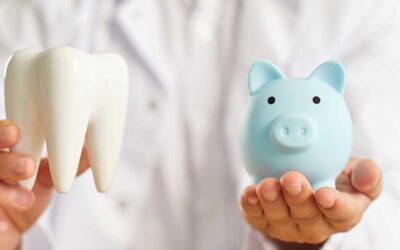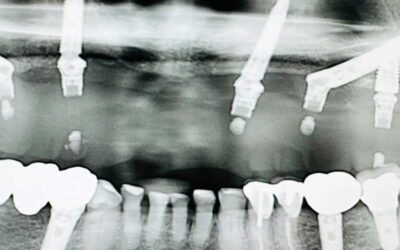Why Sinus Lift? Understanding Its Role in Dental Implant Procedures
If you’re considering tooth replacement options with one of our dual-board certified periodontists, you might hear them mention needing a sinus lift prior to implant placement. Or maybe they point out that there isn’t enough upper jawbone to properly support a traditional dental implant. If that’s the case, what are your options?
At the Center for Advanced Periodontal & Implant Therapy, Dr. Alexandre Aalam and Dr. Alina Krivitsky offer sinus lift surgery as well as alternatives like zygomatic dental implants for those that qualify. If you’re someone with extensive bone and tooth loss, it helps to be familiar with all of your options before committing to any specific implant restoration.
What is a Sinus Lift (Augmentation)?
Sinus lifts (also known as sinus augmentation) are used for our Los Angeles implant patients who lack adequate bone support on the upper jawbone, or what we call the maxillary ridge. If there is not enough bone support in the upper jaw, a standard dental implant can’t be installed. Not only is there no bone to support it, but the implant could possibly rupture the nasal sinus lining just above the thin bone ridge.
Dr. Alexandre Aalam and Dr. Alina Krivitsky will take a 3D CT scan of your jaw during your initial evaluation to measure and evaluate bone density and determine if you qualify for implant treatment. Luckily with sinus lift therapy, it’s possible to increase the bone height, raise the nasal sinus lining, and create a safe place to install your future dental implant(s).
Sinus Lift Procedure: What to Expect
This oral surgical procedure is most commonly performed by a specialist such as an oral surgeon or periodontist. As dual-board certified specialists, Dr. Alexandre Aalam and Dr. Alina Krivitsky offer this advanced surgery here at our Los Angeles office.
The procedure involves making a small access window in the upper jawbone that will expose the floor of the sinus cavity, or sinus membrane. This membrane will be gently lifted up and away from the thin bone ridge to allow room for bone grafting material to be placed in that space. This graft adds bone height and density, making it safe and stable enough to support an implant.
A sinus graft is basically a very simple procedure that we do in our office under IV sedation where we are able to go and by specific techniques, open the sinus and add the bone graft material under the line lying membranes of the sinus rebuilt the bone that is missing and sometimes simultaneously sometimes in the deferred manner place the dental implants to be placed in a perfectly acceptable position and adequately so the teeth that will come behind them will have proper function and be able to help you to chew your food and masticate properly.
Bone grafts come in different forms, such as autogenous bone, xenograft bone, or allogenic bone; our specialists will discuss what product will be used during the initial consultation appointment and why it is recommended.
Post-Surgery Recovery
Once bone grafting is complete, our periodontal specialist will close the access point and place a few small stitches. Within the first few days or so after the sinus lift is completed, it’s fairly normal to experience some slight discomfort, swelling, or even light bleeding near the surgical site or from your nose. These are all normal after surgery and should not last for more than a few days.
We may also prescribe antibiotics, pain relievers, or special mouthwash to help prevent any post-operative infections. The average healing time usually requires several months, as the bone needs time to rebuild itself and integrate with your jaw. Once fully integrated, the dental implant can be installed.
This process helps to increase the number of patients that are eligible for implant placement. However, some patients may opt for alternatives to sinus lifts to avoid additional oral surgery.
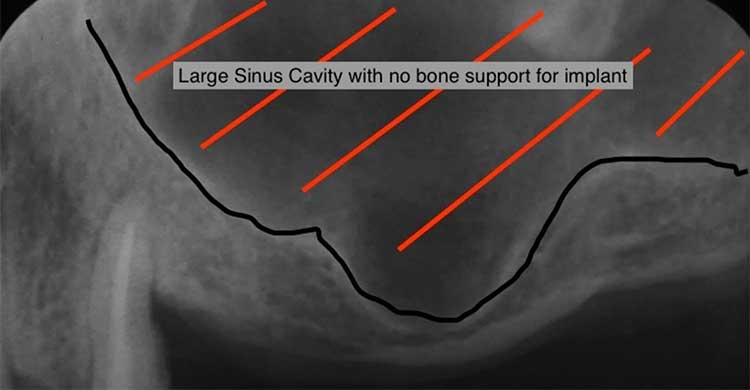
Large sinus cavity with no bone support for implants
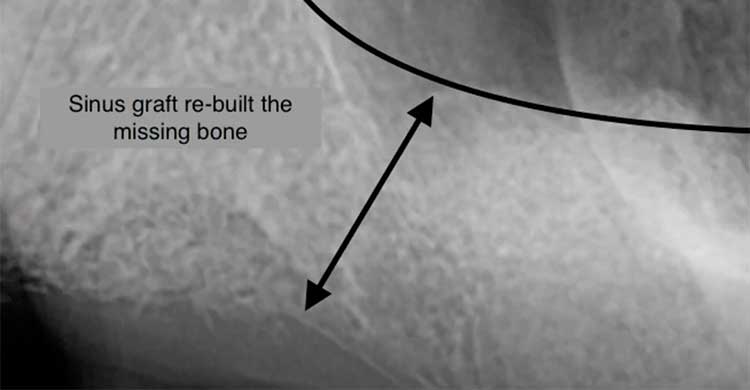
Sinus graft re-built the missing bone
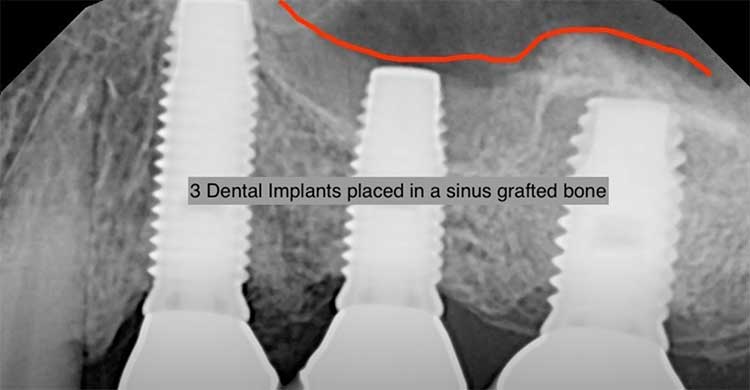
Three implants placed in sinus grafted bone
Alternatives to Sinus Lift Surgery: Zygomatic Dental Implants
Don’t like the idea of sinus lift surgery or bone grafting? One great alternative to a sinus lift is something called zygomatic implants. While traditional dental implants are placed directly into the bone that holds your typical tooth roots, zygomatic implants are quite different. Their design is longer so that they can be angled and placed directly into the patient’s zygomatic or “cheek” bone. If you do not have the required amount of bone for traditional dental implants to be placed and prefer to skip the dental sinus lift procedure, a zygomatic implant may be a great alternative.
Zygomatic dental implants are a specialized treatment that experts like Dr. Alexandre Aalam and Dr. Alina Krivitsky can complete right here in our office. They allow our patients to get right to the implant process rather than having to wait a significant amount of time for sinus lift procedures or a long recovery period. Zygomatic dental implants are considered to be less invasive than sinus lift surgeries and can be a great option for eligible patients.
Additional Procedures Before Implant Placement That May Be Necessary
While it’s certainly important to ensure each of our Los Angeles patients has enough bone prior to dental implant placement, it’s also important for patients to understand other common procedures that are likely necessary prior to any sinus lift or implant placement.
One of the most common procedures is tooth and root extractions before the implants are installed. If you’re getting implants, it’s most often due to the loss of a natural tooth. Whether a tooth is decayed beyond saving, infected, broken, or fractured, the removal of these remaining teeth must be completed prior to implant placement.
When teeth or tooth roots are extracted, they can leave an open “socket.” In this case, socket preservation may be necessary. Socket preservation is when we place bone grafting material into the open socket prior to implant installation. This helps to fill in the voids created and prepares the jawbone for the osteointegration of your new dental implant.
Another procedure that may be recommended in conjunction with implant placement is something called platelet-rich fibrin. Platelet-rich fibrin, also known as PRF, takes a patient’s own blood fibrin or platelet-rich plasma proteins and uses it to assist in the healing after implants and bone grafting materials are placed. This procedure helps to significantly increase the chances of successful implants and greatly reduces recovery time after surgery.
Your Options at the Center for Advanced Periodontal & Implant Therapy
You can expect the latest and most advanced dental care from our skilled periodontists at the Center for Advanced Periodontal and Implant Therapy. Dr. Alexandre Aalam and Dr. Alina Krivitsky specialize in periodontal and implant procedures and are happy to answer questions and concerns regarding your oral health.
We understand that dental surgery can be overwhelming, which is why we do everything we can to ensure your comfort and satisfaction from start to finish.
Schedule your initial consultation with us today and learn why we are the first choice for patients who want the best periodontal and implant care in Los Angeles. Whether you need a dental implant, sinus lift, or other specialized treatment, we’re here to help guide you through the process with expertise and compassion.
You May Also Like...
How Much Do Dental Implants Cost in Southern California? A Complete Guide
If you're considering dental implants in Southern California, you’re likely wondering: How much will they cost? Are...
Can Zygomatic and Pterygoid Implants Be Done in a Day? Breaking Down the Process
Losing bone in the upper jaw can feel overwhelming, especially if you've been told traditional implants aren’t an...
Are Dental Implants Noticeable?
If you've lost one or more teeth due to periodontal disease, trauma, or other dental issues, you might be considering...

